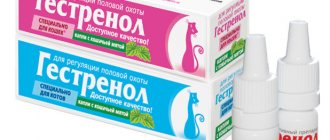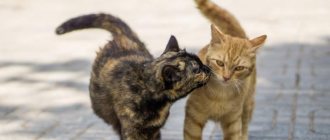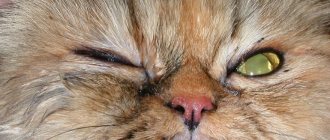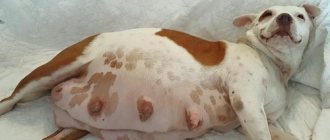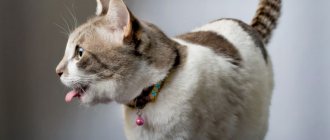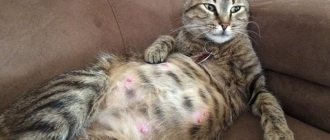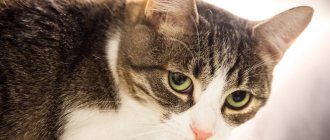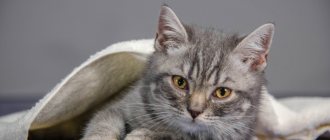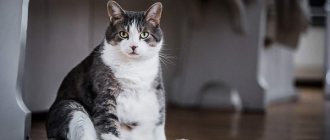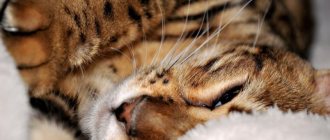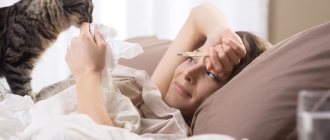Can a cat get pregnant during lactation?
Can a nursing cat get pregnant again? Certainly! On average, a cat begins to go into heat 1.5-2 months after the birth of kittens. And some favorites are ready for mating even earlier: 1.5-2 weeks after lambing. Consequently, pregnancy can occur in a cat that has recently given birth to babies. By the way, some owners unknowingly claim that during the period of feeding kittens, their mother is not able to become pregnant again. This opinion is based on the fact that the hormone prolactin, produced during pregnancy and lactation, prevents the conception of new offspring by blocking the hormones responsible for ovulation. This statement is true for breastfeeding women, but not for cats. The fact is that ovulation in pets occurs at the moment of mating, as soon as interest in carnal pleasures appears during the estrus that appears after lambing. Thus, the question of whether a cat can become pregnant while nursing kittens can be answered in the affirmative.
Estrus: signs that a cat is ready for mating
When a cat's body reaches puberty, it is ready to breed. A meeting with a cat must be organized during the cat’s sexual activity (estrus). Estrus occurs in several stages:
- At the first stage, the pet’s body prepares for reproduction. This stage is called proestrus and is regulated by hormones from the hypothalamus and pituitary gland. The hormones released prepare the reproductive tract for mating and fertilization.
With the onset of sexual heat, the cat’s behavior changes dramatically. She becomes restless, affectionate, loses her appetite, rubs against her owner’s legs, screams and purrs invitingly. Particularly active cats begin to mark their territory, scratch walls and furniture, and try to slip out into the street and escape. Proestrus lasts on average 1-3 days. The pet is not yet ready to mate, so she does not let the cat near her and behaves aggressively towards him.
The second stage of estrus is estrus. At this stage, all the cat’s actions are aimed at attracting a partner. She trembles with excitement, rolls on her back, squats, lifts her butt, moves her tail to the side, and meows shrilly. The cat's genitals swell.
It is customary to breed a cat at this stage. In order for the mating to be successful and the cat to become pregnant, experienced breeders recommend taking her to the cat on the second or third day of estrus.
The third stage of estrus is metestrus. At this stage, if fertilization has occurred, the cat’s sexual instinct fades away. She begins to be aggressive towards the cat and no longer lets him near her.
conclusions
People who own cats should be aware that after giving birth the cat may go into heat. If you follow the deadlines for the period intended for rehabilitation, this will not only help preserve the health of the feline representative, but also wait for full-fledged offspring in the form of healthy kittens.
Thus, the conclusion is this: a nursing cat, and the owners need to draw certain conclusions: allow pregnancy or prevent it.
When a fluffy, uncastrated young beauty lives in the house, sooner or later the owner is puzzled by the question of what time the cat can become pregnant. Knowledge in the field of physiology, understanding of the characteristics of sexual behavior, and the nuances of reproduction will help you competently approach the problem of keeping and breeding a pet.
The cat family is distinguished by its early maturity and fertility. This is also true for pets. A number of factors will influence when a cat can become pregnant for the first time:
- individual characteristics,
The average cat is in her first heat. and with it the opportunity to become pregnant occurs at 6 - 8 months. Later, large breeds and those with long coats mature. In representatives of such breeds as Maine Coon, bobtail, Siberian, Norwegian forest cat, the first heat occurs at 12 - 14 months.
Large breeds of cats mature later, their first heat occurs at 12-14 months
From the moment of the first heat, the pet is physiologically ready to become a mother and retains this ability for almost the entire adulthood. There is no such thing as menopause in the cat family. The reproductive period begins with the first heat and can last until death. Owners of furry pets should be aware of this feature in order to understand that the answer to the question of how many months a cat can become pregnant is quite simple - immediately after puberty.
The task of the animal owner is first and foremost to preserve the health of the pet. That is why experienced breeders and veterinary specialists believe that the first estrus should under no circumstances result in the animal becoming pregnant. A young body must get stronger and take shape. Pregnancy, childbirth and feeding offspring require a lot of effort.
Breeding experts and veterinarians recommend skipping the first 2 - 3 heats, and only after that organize mating. For this purpose, an experienced (untied) cat is selected.
After giving birth, a cat usually comes into heat within 1.5 - 2 months. Often signs of heat are observed earlier - 2 weeks after lambing. However, you should plan your next pregnancy no earlier than 5–6 months. Even if the previous lambing and birth passed without complications, the pet must regain strength. Carrying kittens
, labor activity is associated with large losses of nutrients and minerals. The mother loses a lot of calcium, phosphorus, and vitamins, giving these and other components to the formation of the offspring. In addition, the female should regain her weight and normalize her hormonal levels.
In this regard, responsible and competent breeders recommend planning the birth of a purebred pet no more than once every 1 - 1.5 years. This interval between births will allow you to restore strength and improve your health for the next pregnancy.
It is no coincidence that the cat family is considered one of the most prolific. This fully applies to home beauties. Over the course of a year, a sexually mature cat can give birth 4 to 5 times. This frequency is typical for animals with free access to the street. In the absence of control over sexual behavior, pregnancy can occur even in a nursing cat. This leads to exhaustion, weight loss, curvature of the spine, and the development of inflammatory diseases of the reproductive organs.
If the owner approaches breeding issues responsibly, he will not allow her to become pregnant during every heat. There should be a rehabilitation period of at least 4 to 5 months between births.
Many owners, interested in breeding issues, want to know when cats stop giving birth. The peculiarities of the sexual behavior of domestic beauties allow them to continue their feline lineage throughout their lives, until very old age. Older pets usually give birth to fewer kittens than young animals. Nevertheless, pregnancy also occurs in an older cat by cat standards.
The owner must take a responsible approach to breeding issues and not allow mating of animals older than 7 years. Once your pet reaches this age, she should be sterilized. This point of view is shared not only by veterinary specialists, but also by experienced and competent breeders. No self-respecting breeder will produce offspring from a cat older than 6-7 years.
Contraceptive injection
The above hormonal drugs are available in various forms: tablets, drops, suspensions. The principle of their action is based on suppressing sexual desire and preventing ovulation. Veterinary experts do not recommend the uncontrolled use of oral contraceptives in cats. Owners should be aware that these drugs often cause the development of a dangerous disease for the animal - pyometra.
There is also a contraceptive in the form of an injection - “Covinan”. This hormonal drug eliminates the animal's estrus for about six months. A special feature of the drug is its use before symptoms of estrus are detected. The injection is performed at a veterinary institution according to a specific scheme. Like all hormonal contraceptives, Covinan also has contraindications and increases the risk of developing pathologies of the reproductive system.
A loving and responsible owner of a furry beauty should know not only what time cats can give birth, but also many other issues related to breeding. It is important to remember that the animal needs a rehabilitation period between births, and that cats over 7 years old are not recommended to have offspring. A competent attitude of the owner to breeding issues will ensure the health and long happy life of the animal.
General recommendations
Caring and competent owners, as a rule, took care of a place for a pet with kittens in advance. If for some reason the nest was not prepared, then the first thing that needs to be done for the lambing cat is to prepare the nest for the mother and offspring.
The best option for these purposes is a box made of thick cardboard. The bottom should be covered with waterproof material, a soft mattress or many rags should be placed on top, and a disposable baby diaper should be covered. This arrangement will help keep the nest warm, dry, and clean.
A window should be cut in the wall of the box at such a height that it is convenient for the cat to leave the house, and the babies cannot crawl out. The size of the nest must be optimal. In a spacious box it will be difficult for the mother to warm the kittens, and in a cramped room there is a high probability of overheating and injury. A good solution to the problem may be to use an exhibition box.
Owners often wonder: after a cat has lambed, what to do with her and her offspring? The box with the newborn babies and mother should be placed in an isolated room, without access to strangers and animals. The room should be dry, draft-free, darkened. The nest should not be placed near radiators or heating devices.
The optimal ambient temperature is not lower than 26 C. If necessary, additional heating should be used for babies. An electric heating pad with an adjustable temperature setting and an infrared light lamp are suitable for these purposes. You should know that in the first 7 days, newborn kittens need a temperature in the range of 29 - 32 C. This is due to the fact that babies do not have mechanisms to regulate the temperature balance of the body, and they can die from low temperature.
After a successful birth, the owner must monitor the pet’s behavior and observe whether all kittens have access to the mother’s nipples. Helping a cat should be unobtrusive. Newborns should only be handled as a last resort. This must be done by first washing and disinfecting your hands, wearing sterile gloves. The immune system of babies is weak, so the risk of developing viral diseases is high.
If there are children and other animals in the house, then it is necessary to prevent their access to newborn kittens and the mother. Childbirth is highly stressful, and additional psycho-emotional stress can lead to the cat abandoning its offspring.
Why is contact between a nursing cat and a cat harmful?
Let's say a cat owner has the opportunity to adopt kittens. So why is it worth stopping a cat’s attempts to mate with males while she is still feeding her babies? There are many reasons for this:
- Pregnancy, childbirth and feeding kittens is a difficult time for an animal. A lot of effort is expended, most of the vitamins and minerals obtained from food are spent on the growth of embryos, and hormonal changes occur in the mother cat. Too frequent births simply wear out the pet’s body. Often, cats that give birth frequently have problems with bones and reproductive organs. Animals that become pregnant again after giving birth to kittens usually cannot boast of longevity. Veterinarians believe that the optimal number of births for an adult healthy pet is once or maximum twice a year. Frequent pregnancies are a real stress for the reproductive system and the entire body of the animal;
- In fact, the offspring abandoned by a mother cat who has gone on a spree have to be fed by the owner himself with a milk replacer from a pipette or syringe. And this is quite tedious, since it is difficult to feed a small kitten. Yes, and it’s costly financially. Even if the pet does not completely stop feeding its young, its lactation will still be reduced;
- A nursing cat can become pregnant within a couple of weeks after giving birth, when the mucous membrane of her genital organs is still susceptible to infection;
- A nursing mother cat should eat well and gain strength after giving birth. But if the pet begins to go into heat, her appetite will be reduced or disappear altogether, which will negatively affect the condition of the body. As a result, both the adult animal, the recently born kittens, and the embryos from the next litter will suffer.
Pregnancy with one fallopian tube after laparoscopy
Is it possible to get pregnant if one of the fallopian tubes was removed during laparoscopy? It all depends on how timely the laparoscopy was performed, as well as on the condition of the second surviving tube.
If the laparoscopy was late and the fertilized egg managed to rupture the oviduct, it is removed, which significantly complicates the onset of further pregnancies, since only one tube remains. However, a huge number of women, after removal of the oviduct, retain the ability to reproduce: they manage to get pregnant, and even more than once. The main condition is the presence of a healthy patent second tube with a normal functioning ovary.
Unfortunately, according to statistics, women over 35 years of age are much less likely to become pregnant if they have one fallopian tube, since with age the capacity of the ovary decreases, endometriosis and adhesions, as well as other chronic pathologies of the genital area, may appear. In such a situation, women often resort to in vitro fertilization (IVF), in which it is possible to become pregnant even if the remaining tube is completely blocked.
Before planning a pregnancy with one tube, you must remember that in such a situation the risk of developing a repeat ectopic pregnancy increases significantly. Therefore, if a woman becomes pregnant with one fallopian tube, then she needs special supervision by a gynecologist, with constant monitoring of hCG and ultrasound.
Natural food products
Products are chosen fresh, rich in proteins, calcium, carbohydrates and beneficial elements.
Among them:
- boiled lean meat: chicken, beef, rabbit, turkey, veal;
- vegetables: beets, pumpkin, cauliflower, carrots, zucchini;
- cottage cheese, curdled milk, natural yoghurts, biokefir;
- cereals: buckwheat, oatmeal, sprouted wheat grains.
To reduce the risk of developing constipation due to intestinal problems, add to the main diet:
- low-fat broths in which meat was cooked;
- warm milk (in small quantities);
- 3 – 4 drops of flaxseed, olive, sesame oil (added to food);
- boiled beets or puree from them;
- young shoots of oats, wheat, barley.
Approximate diet
In the second week of pregnancy, the cat’s appetite increases, therefore the amount of food is increased by 10% of the previous volume, from the second month - by 50%. In the last weeks before childbirth, appetite decreases, it is recommended to reduce portions, and the number of feedings is calculated based on the needs of the expectant mother. An adult animal needs 180-200 grams per day to be satisfied.
Diagnosis of endometriosis
It is quite difficult to identify endometriosis without a comprehensive examination. In our clinic, in addition to the standard gynecological examination, colposcopy, rectovaginal examination, for the diagnosis of endometriosis
held:
- cytological examination;
- transvaginal ultrasound;
- cystoscopy with biopsy;
- hysteroscopy and hysterosalpingography.
Also, to determine the degree of involvement of other organs in the process, ultrasound of the kidneys and urography, computed tomography and magnetic resonance imaging are prescribed.
One of the most effective examinations is laparoscopy, which allows you to accurately determine the degree and form of the disease. However, during pregnancy, diagnosis of endometriosis using laparoscopy or hysteroscopy is not carried out due to the potential risk. It is only possible to remove large ovarian cysts at 16-20 weeks.
For a free written consultation, you can send me a complete description of the pelvic ultrasound, pelvic MRI data, indicate age and main complaints to my personal email address. Then I will be able to give a more accurate answer to your situation.
How to prevent pregnancy in a nursing cat
If the cat does not participate in breeding, and its offspring are not of particular financial interest to the owner, it is advisable to sterilize the animal. The best time for this is after 6 months - 1 year. Theoretically, it is possible to perform surgery on a nursing mother cat to prevent her from becoming pregnant again. If sterilization is undesirable, you can give your pet sedative medications based on medicinal herbs (such as “Cat Bayun”, “Fitex”). You also need to monitor your nursing cat, especially if she goes into heat soon after pregnancy. That is, it is necessary to exclude contacts between the female pet and cats.
You should not use alcohol tincture or valerian tablets as a natural sedative. This remedy for pets is a drug that puts them in a state of extreme excitement. That is, a cat who has started to heat, after a small amount of valerian solution or tablets, will have one goal - to quickly connect with the cat. The existing kittens will naturally go to the side.
Also, hormonal drugs that suppress sexual desire are also extremely undesirable for calming a nursing pet. Products of this type (“Sex barrier”, “Contrasex”, etc.) have a lot of contraindications, and they cannot be used by cats during lactation.
Use of contraceptives
Special pharmacological preparations containing synthetic hormones can alleviate the condition of an animal during estrus by reducing the intensity of signs of sexual heat. However, more and more veterinarians are urging owners to stop using them due to complications that arise, which include:
- purulent inflammation of the uterus;
- ovarian cysts;
- nymphomania;
- infertility;
- diabetes;
- dysfunction of the adrenal glands;
- benign and malignant tumors of the mammary glands and uterus.
As an alternative, females can be given sedatives to relieve emotional stress.
What to do if a nursing cat becomes pregnant
If the tailed “lady” is still pregnant again, despite the fact that very young kittens are waiting for her at home, the owner has this simple choice:
- Allow the cat to give birth to her next babies, and then bring her to the veterinary clinic for surgery to remove the ovaries or remove both the ovaries and the uterus;
- Show the pregnant cat to a specialist and seek advice about surgical abortion (an incision will be made in the uterus through which the embryos will be removed). It is important to do this no later than 4-5 weeks of pregnancy;
- Contact a veterinarian for abortion and sterilization of the pregnant pet (the babies will be removed along with the uterus and ovaries);
- Consult your veterinarian about medical abortion using hormonal medications.
It is absolutely clear that all of the above methods can harm the cat: severe consequences after anesthesia, possible infection, gynecological diseases and the inability to become pregnant in the future. Therefore, it is advisable to prevent an unwanted pregnancy in a cat in advance by excluding its contact with cats and using sedatives. The most radical method against pregnancy is sterilization.
How to understand that there is little or no milk?
It is important to detect in time that the mother has little milk and the kittens are not getting enough to eat. This will allow babies to grow strong and healthy.
First of all, the owner should pay attention to newborns: if the kittens constantly squeak, worry, do not fall asleep after feeding, or constantly poke their noses at their mother, these are sure signs that they are not getting enough to eat. A well-fed baby should fall asleep immediately after feeding, sometimes right on the mother's breast
There may not be enough milk if too many babies are born. The weakest of the litter, the last to be born, remain hungry and meow the loudest. Regular weighing of kittens will accurately determine whether they have enough milk. The baby should gain 10–15 g per day. Lack of weight gain for several days indicates underfeeding - the baby’s health is at risk.
Some cats, in the absence of milk, do not want to be near their children and try to abandon them, bite them, and go to another place. Other mothers continue to feed their offspring with empty breasts, warming and licking the cubs. In such a situation, the owner should be wary that the kittens constantly suckling their mother do not gain weight and squeak continuously.
Keeping and caring for a pregnant cat
Make sure that your pet jumps less: during pregnancy, the center of gravity shifts and she may fall unsuccessfully and be injured. During a dangerous jump, the offspring may also be harmed.
What to feed a pregnant cat
When focusing on industrial feed, choose packs labeled “holistic” or “super premium”.
The list of healthy natural foods includes:
- boiled beef or veal;
- broth, boiled pork or sea fish;
- boiled eggs (twice a week);
- dairy products less than 15% fat, including cottage cheese, yogurt, milk, cream, sour cream, yogurt (without additives);
- porridge made from rice, oatmeal and buckwheat;
- boiled or raw vegetables/fruits (cat’s choice);
- jellied meat and boiled cartilage.
For constipation, give butter, beets and fatty foods, removing them as soon as the stool improves.
Important!
To avoid complications during childbirth, give your cat a decoction of raspberry leaves (1 tablespoon per 0.25 liters of water). The broth is filtered and given a teaspoon per day.
Feeding rules:
- feed your pet 4-5 times a day;
- increase the daily diet by 1.5-2 times from the 2nd period of pregnancy;
- for meat (with natural feeding) allocate half the daily allowance;
- supplement natural food with vitamin and mineral supplements.
In the 2nd semester of pregnancy, add chopped nettle leaves to your food (after scalding with boiling water): this will enhance lactation.
Activity and rest of a pregnant cat
Cats in an interesting position tend to laze around more and move less. There is a certain reason for this - this way they minimize accidental injuries, but there is also a danger - becoming fat from physical inactivity, complicating the upcoming birth with excess weight. Encourage your cat to play and exercise more in the early stages of pregnancy by preventing her from jumping from great heights.
In the later stages, completely block access to high places and allow the expectant mother to rest as much as possible. Take care of the quality of her sleep by limiting the number of guests you have, not playing loud music, eliminating screams and noise. Create greenhouse conditions for her: equip a house or an insulated bed, placing them in the quietest corner of the apartment.
Important!
If your pet is used to walking in the yard, do not let her go there shortly before giving birth, otherwise the litter will be born in unsanitary conditions.
Vaccination of a cat during pregnancy
It is important to eliminate ticks, fleas and lice-eaters before conception, which not only annoy the animal, but also carry dangerous diseases that can cause miscarriage. Most preventive medications contain pesticides that penetrate the stomach and blood. Unfortunately, the placenta is not a barrier to poison that can stop the development of the fetus or cause deformity, miscarriage and congenital pathologies.
Physical condition monitoring
Caring for an animal requires owners to monitor the temperature and nature of the discharge. Your pet's body temperature should be measured at least once a day: if it is above 39°C or below 38°C, call your veterinarian immediately. An increase in temperature most likely indicates an intrauterine infection or septic mastitis, which can kill a cat and litter in a matter of hours. A decrease in temperature may be a symptom of internal bleeding or disruption of the vital functions of internal organs.
What lochia (normal postpartum discharge) looks like is described above. In rare cases, bleeding is possible as a result of damage, rupture of the cervix during expulsion of the fetus or subinvolution of the uterus. Signs: scarlet liquid or copious mucus with blood clots flows from the vulva, the cat first behaves restlessly, then rolls over on its side and lies with its tongue hanging out and breathing rapidly, after a while breathing becomes shallow, heart rhythm is disturbed. If the owner notices blood, call the veterinarian immediately! Without treatment, the cat goes into shock and dies.
In addition to bleeding, other complications are possible:
Mastitis is inflammation of the mammary glands due to excess or stagnation of milk. Congestive mastitis is mild redness and soreness of the nipples with a satisfactory general condition of the pet. If you press on the nipple, milk will flow out of it - normal color and consistency. Light massage, pumping, and warm compresses are indicated. Acute mastitis (septic) develops if congestive mastitis is not treated in any way: bacteria enter the cracks in the inflamed nipples, leading to infection of not only the pet, but also the milk. In this case, breast discharge looks like yellowish mucus with streaks of red and/or green, sometimes the mucus is replaced by a cheesy paste. The bacteria contained in purulent “milk” are dangerous for kittens, even to the point of sudden death of the entire litter. Therefore, the cat is isolated and treated as recommended by the veterinarian, and the babies are transferred to artificial feeding.
Eclampsia is an acute condition that requires immediate veterinary intervention. Reasons: acute lack of calcium in the body, which is consumed in huge quantities during pregnancy and milk production. Eclampsia is not always the result of calcium deficiency in food; many pets are genetically predisposed to this condition (in this case, sterilization after feeding babies is indicated)
Signs as they increase: restless behavior, inattention to kittens, shaky, uncertain or excessively abrupt unnatural gait, stiffness of movements, exposed teeth due to tense lips. The attack may stop suddenly, but will certainly recur after some time (without treatment)
If you do not help the pet at this stage, the cat falls backward, breathes heavily, convulsions begin, profuse salivation, and possible loss of consciousness. Without treatment, death is likely within 7-12 hours.
Metritis is an inflammation of the uterus that occurs due to an infection that has gotten inside (unsanitary conditions during childbirth, dirty hands of the obstetrician, dirty bedding, etc.) or as a result of decomposition of organic matter that is not released naturally. Signs: the cat is bleeding (the discharge is profuse, thick and foul-smelling), depressed and apathetic, the temperature is elevated, fever is possible. The condition is life-threatening; emergency veterinary assistance is required! To avoid metritis, the doctor should examine the pet immediately after birth. In some cases, injections of oxytocin are indicated to maintain uterine tone. In severe cases, emergency sterilization is necessary.
Hypogalactia or agalactia is a lack or absence of milk. There are many reasons: insufficient feeding, a large number of kittens, psychological discomfort of the mother, congenital abnormalities in the development of the mammary glands. Only a veterinarian can help after determining the cause of the lack or absence of milk.
Sometimes the animal’s behavior threatens the lives of the babies: the pet throws one or all kittens out of the “den,” refuses to accept the babies, does not lick them, and in rare cases may even try to kill or eat the baby. In most cases, it is impossible to establish the reason for such behavior, because the cat acts in accordance with instincts and not logic. There is no need to scold your pet - the situation will only get worse. Kittens should be removed from their mother and transferred to artificial feeding, without stopping attempts to introduce them to the cat, but only under supervision. If the mother allows the babies to reach the nipples, begins to lick them and clean up the feces after them, you don’t have to worry - she finally realized that these are her babies.
